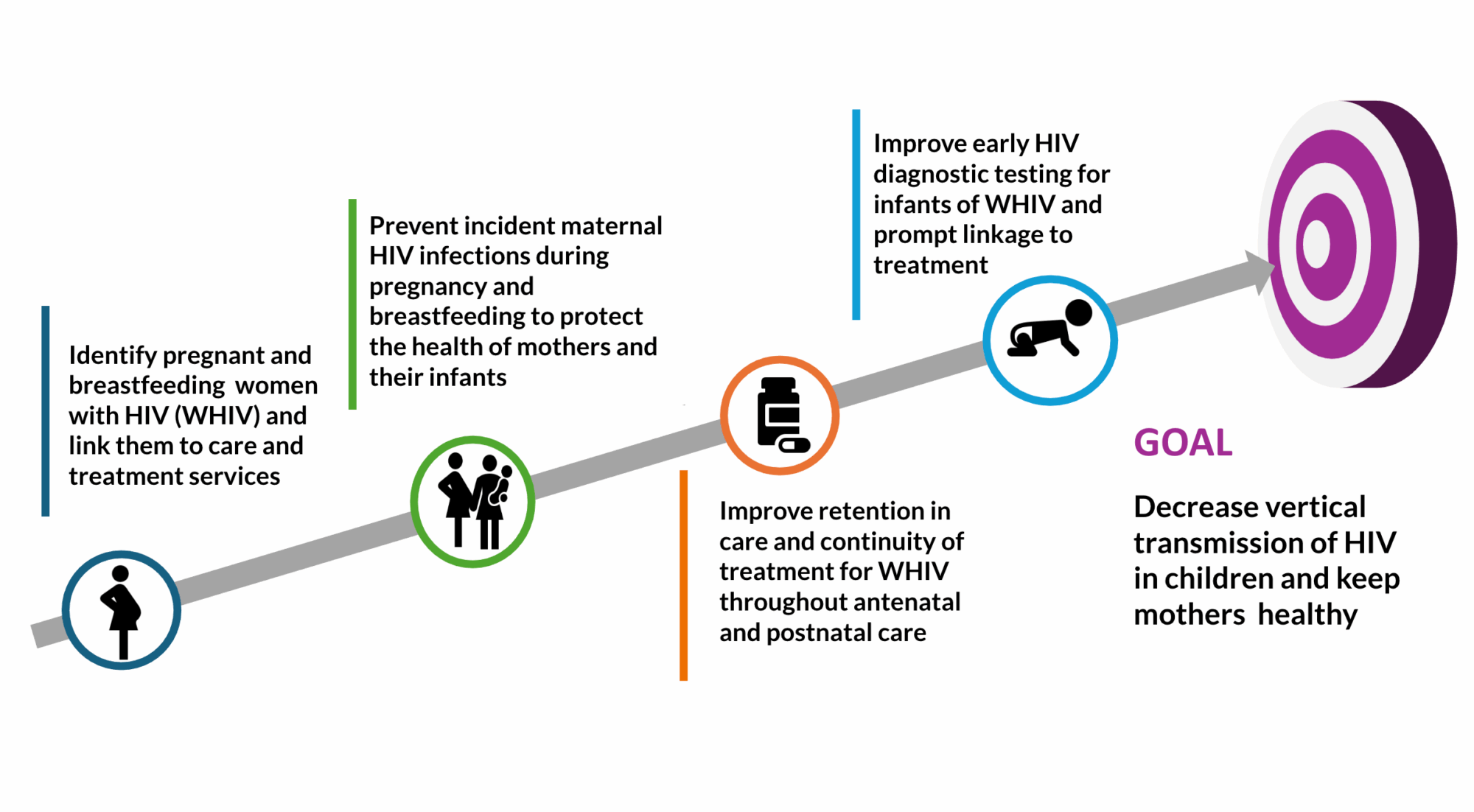Meeting the Moment
HIVE’s response to the changing HIV landscape
In early 2025, the challenges facing HIVE network members changed almost overnight. The HIV programs in all six member countries abruptly lost funding, staff, and implementing partner support. The resulting interruption of HIV prevention, testing and treatment services rapidly weakened initiatives to eliminate vertical transmission of HIV (VTE). The HIVE team has been collecting landscaping data from HIVE partner countries, which indicate threats to every component of national VTE service delivery, as well as disruptions in health system elements supporting vertical HIV transmission prevention (VTP), including staffing, mentorship, supportive supervision, data systems, and monitoring and evaluation capabilities.
Key service delivery and health systems challenges identified include:
Identification of pregnant and breastfeeding women with HIV (WHIV) and initiation of antiretroviral treatment (ART)
- The scaling down of HIV testing for pregnant and breastfeeding women in most HIVE partner countries is obstructing early identification of WHIV, which in turn delays prompt initiation of ART.
Prevention of maternal HIV infections during pregnancy and breastfeeding
- The scaling down of HIV pre-exposure prophylaxis (PrEP) services in several countries is impeding prevention of new maternal HIV infections, during pregnancy and breastfeeding, leaving women unprotected during critical windows of vulnerability.
Retention in care and continuity of treatment for WHIV and their infants through pregnancy and breastfeeding
- The HIV service disruptions and workforce layoffs in many HIVE partner countries are hindering the sustained retention of WHIV and their infants during pregnancy and breastfeeding. This gap in the continuum of care undermines efforts to prevent vertical transmission and protect maternal and child health.
Early HIV diagnostic testing, postnatal prophylaxis and ART initiation for infants newly diagnosed with HIV
- Disruptions in HIV testing for perinatally exposed infants in a majority of HIVE countries were noted primarily due to interruptions in the transportation of samples to laboratories. These disruptions have led to missed opportunities for the early identification of infants with HIV infection and timely initiation of ART.
Monitoring and Evaluation (M&E) and Data Systems
- M&E and data system components have been heavily disrupted across HIVE partner countries, affecting critical elements such as data collection instruments, human resources, capacity-building initiatives, data availability, and data utilization for programmatic decision-making. Without sustained investment, programs are likely to experience compromised data integrity, reporting lags, and diminished operational capacity to track key indicators or respond to emerging threats among pregnant and breastfeeding women and their infants.
Mentorship, Training, Capacity Building and Supportive Supervision
- Core health system strengthening activities—including strategic planning and review forums, in-service training, interagency coordination platforms, provision of technical assistance, capacity development interventions, and routine supportive supervision—have been widely disrupted across the majority of HIVE partner countries. These disruptions could undermine the operational effectiveness of Ministry of Health personnel and compromise the quality and continuity of service delivery.
Human Resources for Health (HRH)
- Human resource constraints and their associated repercussions have been widely reported across HIVE partner countries, where the VTP workforce—particularly data clerks, mentor mothers, nurses, and HIV testing counselors—has been affected by staffing reductions and overall diminished operational capacity. These human resource constraints have led to reduced service delivery capacity, compromised data quality and reporting, limited client follow-up, and decreased availability of psychosocial and adherence support for pregnant and breastfeeding women and their infants.
In response, the HIVE network is pivoting to support its partner countries as they respond to this unprecedented challenge
Based on discussions with Ministries of Health and other stakeholders, HIVE envisions that country responses will include three overlapping phases:
Stabilization: In this phase, countries will assess remaining programs and resources, identify a feasible core or minimum package of VTP services, and ensure their deliver
Redesign: Given the reality of significantly reduced external funding, countries will also need to re-imagine their HIV and VTE programs, from financing to program design. In many countries, this will involve the integration of HIV and primary health care (including human resources, laboratory systems, procurement and pharmacy systems, monitoring and evaluation, and quality management) as well as integration of HIV services (prevention, testing, and treatment) into primary care settings. HIVE is supporting partner countries in this phase by creating platforms for interaction to share challenges and adaptation approaches. Two such webinars have been conducted so far, and the presentations can be accessed here.
Implementation: Once these critical policy decisions are made, countries will need to implement and sustain their redesigned VTE programs. This will require rapid revision of training curricula, standard operating protocols, data management and M&E systems, quality assessments, community-led monitoring, and more.
.

As Ministries of Health work to protect vulnerable women and children and support health systems, HIVE will document and analyze key policy decisions, sharing findings, best practices, and challenges across partner countries. Encouraging open dialogue and mutual support during this process will inspire innovation and bolster collective resilience. Countries will need to remain agile, adapting their plans as new information unfolds, and the HIVE network will work to ensure that key stakeholders have the information needed to optimize their VTE programs.
HIVE goal and objectives
Resources
- UNAIDS Impact of US funding cuts on the global AIDS response:
- Cluver et al. Protecting Africa’s children from extreme risk: a runway of sustainability for PEPFAR programmes
- UNAIDS Country Profiles: https://sustainability.unaids.org/country-profiles/
- IAS website on U.S. foreign aid freeze: https://www.differentiatedservicedelivery.org/us-foreign-aid-freeze/
- PEPFAR – PEPFAR Impact Tracker: Tracking the impact of the suspension of delivery of ARVs
- USAID Impact Tracker
- CHANGE: Community Health & HIV advocates navigating global emergencies
- CHAI HIV Market Impact Memo

